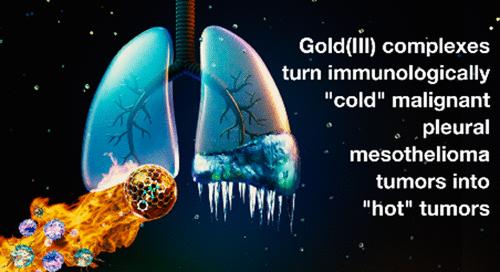Leveraging Immunogenic Cell Death to Enhance the Immune Response against Malignant Pleural Mesothelioma Tumors
IF 14.4
1区 化学
Q1 CHEMISTRY, MULTIDISCIPLINARY
引用次数: 0
Abstract
Although various metal-based compounds have exhibited excellent immunogenic cell death (ICD)-inducing properties both in vitro and in vivo, the majority of these compounds have been discovered serendipitously. In this work, we have successfully synthesized and characterized 35 cyclometalated Au(III) complexes containing dithiocarbamate ligands, with 25 of these complexes being previously unreported. Their ability to induce phagocytosis in vitro against immunologically “cold” malignant pleural mesothelioma (MPM) cells was strongly dependent on the cyclometalated scaffold and the overall lipophilicity of the complexes. We elucidated the role of cell death mechanisms in the observed ICD effects and identified correlations between the ability of the complexes to induce necrotic cell death and ICD, both in vitro and in vivo. Complex 2G, with its high phagocytosis rates and low necrosis rates, was recognized as a bona fide ICD inducer, demonstrating a remarkably long-lasting immune response in vaccinated mice. In contrast, complex 1C, characterized by high phagocytosis rates and high necrosis rates, failed to elicit a sustained immune response upon following vaccination; however, it triggered selective activation of calreticulin in tumors upon direct in vivo administration. Overall, this study offers a framework for predicting ICD effects in vivo for structurally similar Au(III) complexes, with the potential for extension to other series of metal complexes.

求助全文
约1分钟内获得全文
求助全文
来源期刊
CiteScore
24.40
自引率
6.00%
发文量
2398
审稿时长
1.6 months
期刊介绍:
The flagship journal of the American Chemical Society, known as the Journal of the American Chemical Society (JACS), has been a prestigious publication since its establishment in 1879. It holds a preeminent position in the field of chemistry and related interdisciplinary sciences. JACS is committed to disseminating cutting-edge research papers, covering a wide range of topics, and encompasses approximately 19,000 pages of Articles, Communications, and Perspectives annually. With a weekly publication frequency, JACS plays a vital role in advancing the field of chemistry by providing essential research.

 求助内容:
求助内容: 应助结果提醒方式:
应助结果提醒方式:


